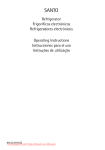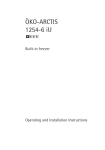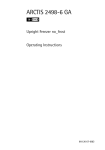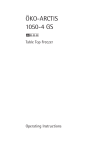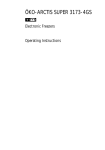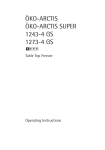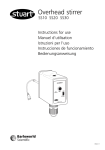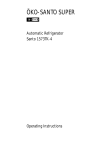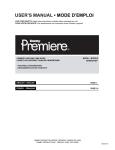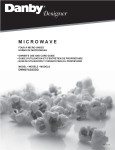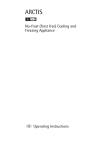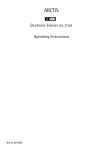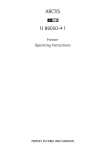Download Electrolux 3193-4GA User's Manual
Transcript
ÖKO-ARCTIS 3193-4GA frost-free Cooling and Freezing appliance Operating Instructions Dear customer, Before placing your new refrigerator into operation please read these operating instructions carefully. They contain important information for safe use, for installation and for care of the appliance. Please keep these operating instructions for future reference. Pass them on to possible new owners of the appliance. These operating instructions are for use with several technically comparable models with varying accessories. Please observe the notes which apply to your model. Notes which are important for your safety or for the correct functioning of the appliance are indicated with a warning triangle and/ or the words (Warning!, Caution!, Important!). Please observe the information carefully. 0 This symbol guides you step by step in the operation of the appliance. 1 3 Additional information regarding operation and practical use of the appliance appear after this symbol. 2 Tips and information concerning economical and environmentally sound use of the appliance are marked with the cloverleaf. Explanations of the technical terminology used in the operating instructions can be found at the end in the section "Technical Terminology". The operating instructions contain instructions for the correction of possible malfunctions by the user in the section "Something not working". If you are unable to rectify the fault after reading this chapter, please contact your local AEG Service Force Centre.. If you require assistance or advice on your appliance, please contact our Customer Care Department by letter or telephone: Tel: Customer Care Department AEG Domestic Appliances Limited 55-77 High Street Slough Berkshire SL 1 1DZ 08705 350350 Printed on paper manufactured with environmentally sound processes. he who thinks ecologically acts accordingly ... 2 Content Important Safety Instructions . . . . . . . . . . . . . . . . . . . . . . . . . . . . . . . . . . . . 5 Environmental Information . . . . . . . . . . . . . . . . . . . . . . . . . . . . . . . . . . . . . . 7 Packaging . . . . . . . . . . . . . . . . . . . . . . . . . . . . . . . . . . . . . . . . . . . . . . . . . . . . . . 7 Old Appliances . . . . . . . . . . . . . . . . . . . . . . . . . . . . . . . . . . . . . . . . . . . . . . . . . . 7 Energy Saving Tips . . . . . . . . . . . . . . . . . . . . . . . . . . . . . . . . . . . . . . . . . . . . . . 7 The most important characteristic of your appliance . . . . . . . . . . . . . . . 8 Appliance design . . . . . . . . . . . . . . . . . . . . . . . . . . . . . . . . . . . . . . . . . . . . . . . Front view . . . . . . . . . . . . . . . . . . . . . . . . . . . . . . . . . . . . . . . . . . . . . . . . . . . . . . Freezer tray . . . . . . . . . . . . . . . . . . . . . . . . . . . . . . . . . . . . . . . . . . . . . . . . . . . . . Quick door-opener . . . . . . . . . . . . . . . . . . . . . . . . . . . . . . . . . . . . . . . . . . . . . . Interior Illumination . . . . . . . . . . . . . . . . . . . . . . . . . . . . . . . . . . . . . . . . . . . . . Control Panel . . . . . . . . . . . . . . . . . . . . . . . . . . . . . . . . . . . . . . . . . . . . . . . . . . . ON/OFF button . . . . . . . . . . . . . . . . . . . . . . . . . . . . . . . . . . . . . . . . . . . . . . . Temperature regulator . . . . . . . . . . . . . . . . . . . . . . . . . . . . . . . . . . . . . . . . . Temperature Display . . . . . . . . . . . . . . . . . . . . . . . . . . . . . . . . . . . . . . . . . . FAST CHILL/-FREEZE button . . . . . . . . . . . . . . . . . . . . . . . . . . . . . . . . . . . . WARNING OFF button . . . . . . . . . . . . . . . . . . . . . . . . . . . . . . . . . . . . . . . . . 9 9 10 10 10 11 11 12 12 13 13 Prior to initial start-up . . . . . . . . . . . . . . . . . . . . . . . . . . . . . . . . . . . . . . . . . . 13 Initial Start-Up . . . . . . . . . . . . . . . . . . . . . . . . . . . . . . . . . . . . . . . . . . . . . . . . . 14 Select "Freezing" or "Cooling" . . . . . . . . . . . . . . . . . . . . . . . . . . . . . . . . . . . 14 Temperature Adjustment . . . . . . . . . . . . . . . . . . . . . . . . . . . . . . . . . . . . . . . . 15 Switch on FAST CHILL . . . . . . . . . . . . . . . . . . . . . . . . . . . . . . . . . . . . . . . . . . . 15 Switch on FAST FREEZE . . . . . . . . . . . . . . . . . . . . . . . . . . . . . . . . . . . . . . . . . 16 Switching the Appliance Off . . . . . . . . . . . . . . . . . . . . . . . . . . . . . . . . . . . . . 17 Control and Information Systems . . . . . . . . . . . . . . . . . . . . . . . . . . . . . . . . . "Open Door"-Warning . . . . . . . . . . . . . . . . . . . . . . . . . . . . . . . . . . . . . . . . . . . . Power Interruption . . . . . . . . . . . . . . . . . . . . . . . . . . . . . . . . . . . . . . . . . . . . . . Temperature Warning . . . . . . . . . . . . . . . . . . . . . . . . . . . . . . . . . . . . . . . . . . . . Partial/Complete Thaw Warning . . . . . . . . . . . . . . . . . . . . . . . . . . . . . . . . . . . Function Errors . . . . . . . . . . . . . . . . . . . . . . . . . . . . . . . . . . . . . . . . . . . . . . . . . . 18 18 18 18 19 19 3 Content Freezing . . . . . . . . . . . . . . . . . . . . . . . . . . . . . . . . . . . . . . . . . . . . . . . . . . . . . . . Freezing . . . . . . . . . . . . . . . . . . . . . . . . . . . . . . . . . . . . . . . . . . . . . . . . . . . . . . . Frozen Storage . . . . . . . . . . . . . . . . . . . . . . . . . . . . . . . . . . . . . . . . . . . . . . . . . . Preparation of Ice Cubes . . . . . . . . . . . . . . . . . . . . . . . . . . . . . . . . . . . . . . . . . . Storage Goods Symbols/Freezing Calendar . . . . . . . . . . . . . . . . . . . . . . . . . . . 20 20 21 22 22 Cooling . . . . . . . . . . . . . . . . . . . . . . . . . . . . . . . . . . . . . . . . . . . . . . . . . . . . . . . . "Long Fresh" Cooling . . . . . . . . . . . . . . . . . . . . . . . . . . . . . . . . . . . . . . . . . . . . . "Standard" Cooling . . . . . . . . . . . . . . . . . . . . . . . . . . . . . . . . . . . . . . . . . . . . . . Cooling drinks . . . . . . . . . . . . . . . . . . . . . . . . . . . . . . . . . . . . . . . . . . . . . . . . . . 22 23 23 23 Cleaning and Maintenance . . . . . . . . . . . . . . . . . . . . . . . . . . . . . . . . . . . . . . 24 Something not Working . . . . . . . . . . . . . . . . . . . . . . . . . . . . . . . . . . . . . . . . . Correcting Malfunctions . . . . . . . . . . . . . . . . . . . . . . . . . . . . . . . . . . . . . . . . . . Replace light bulb . . . . . . . . . . . . . . . . . . . . . . . . . . . . . . . . . . . . . . . . . . . . . . . Adjust door contacter . . . . . . . . . . . . . . . . . . . . . . . . . . . . . . . . . . . . . . . . . . . . 25 25 28 28 Noises during Operation . . . . . . . . . . . . . . . . . . . . . . . . . . . . . . . . . . . . . . . . . 29 Regulations, Standards, Guidelines . . . . . . . . . . . . . . . . . . . . . . . . . . . . . . . 29 Special accessories . . . . . . . . . . . . . . . . . . . . . . . . . . . . . . . . . . . . . . . . . . . . . . 30 Technical Terminology . . . . . . . . . . . . . . . . . . . . . . . . . . . . . . . . . . . . . . . . . . 30 Installing and connecting . . . . . . . . . . . . . . . . . . . . . . . . . . . . . . . . . . . . . . . . Remove transport safeguard . . . . . . . . . . . . . . . . . . . . . . . . . . . . . . . . . . . . . . Installation . . . . . . . . . . . . . . . . . . . . . . . . . . . . . . . . . . . . . . . . . . . . . . . . . . . . . Installation Location . . . . . . . . . . . . . . . . . . . . . . . . . . . . . . . . . . . . . . . . . . The appliance needs ventilation . . . . . . . . . . . . . . . . . . . . . . . . . . . . . . . . . Appliance Alignment . . . . . . . . . . . . . . . . . . . . . . . . . . . . . . . . . . . . . . . . . . Reversing the Door . . . . . . . . . . . . . . . . . . . . . . . . . . . . . . . . . . . . . . . . . . . . . . Door Alignment . . . . . . . . . . . . . . . . . . . . . . . . . . . . . . . . . . . . . . . . . . . . . . . . . Electrical Connection . . . . . . . . . . . . . . . . . . . . . . . . . . . . . . . . . . . . . . . . . . . . 31 31 32 32 33 33 34 36 36 Guarantee Conditions . . . . . . . . . . . . . . . . . . . . . . . . . . . . . . . . . . . . . . . . . . . 37 Service & Spare Parts . . . . . . . . . . . . . . . . . . . . . . . . . . . . . . . . . . . . . . . . . . . 39 4 1 Important Safety Instructions These warnings are provided in the interests of your safety. Ensure that you understand them all before installing or using this appliance. Your safety is of paramount importance. If you are unsure about any of the meanings or these warnings contact the Customer Care Department. Prior to Installation • Check the appliance for transport damage. Under no circumstances should a damaged appliance be installed! In the event of damage, please contact your retailer. Installation • This appliance is heavy. Care should be taken when moving it. • It is dangerous to alter the specifications or attempt to modify this product in any way. • Ensure that the appliance does not stand on the electrical supply cable. If the supply cable is damaged, it must be replaced by a cable available from your local Service Force Centre. • Any electrical work required to install this appliance should be carried out by a qualified electrician or competent person. • Parts which heat up should not be exposed. Whenever possible, the back of the appliance should be close to a wall, but leaving the required distance for ventilation, as stated in the installation instructions. • The appliance should be left for 2 hours after installation before it is turned on, in order to allow the refrigerant to settle. Refrigerant The refrigerant isobutane (R600a) is contained within the refrigerant circuit of the appliance, a natural gas with a high level of environmental compatibility, which is nevertheless flammable. • During transportation and installation of the appliance, be certain that none of the components of the refrigerant circuit become damaged. • If the refrigerant circuit should become damaged: – avoid open flames and sources of ignition; – thoroughly ventilate the room in which the appliance is situated. 5 Important Safety Instructions Child Safety • Do not allow children to tamper with the controls or play with the product. • There is a risk of suffocation! Keep packaging material away from children! During Use • This appliance is designed for domestic use only, specifically for the storage of edible foodstuffs only. It is not intended for commercial or industrial use • Containers with flammable gases or liquids can leak at low temperatures. Do not store any containers with flammable materials such as, spray cans, fire extinguisher refill cartridges etc in the appliance. • Frozen food should not be refrozen once it has thawed out. • Do not place carbonated or fizzy drinks in the freezer compartment. • Ice lollies can cause ’frost/freezer burns’ if consumed straight from the freezer compartment. • Do not remove items from the freezer compartment if your hands are damp/wet, as this could cause skin abrasions or frost/freezer burns. • Bottles and cans must not be placed in the freezer compartment. They can burst when the contents freeze. • Manufacturers´ recommended storage times should be adhered to. Refer to relevant instructions. Maintenance and Cleaning • Before cleaning, always switch off the appliance and disconnect from the electrical supply. • When unplugging always pull the plug from the mains socket, do not pull on the cable. Servicing • This product should be serviced by an authorised engineer and only genuine spare parts should be used. • Under no circumstances should you attempt to repair the appliance yourself. Repairs carried out by inexperienced persons may cause injury or serious malfunctioning. Contact your local Service Force Centre. 6 Environmental Information Packaging All transit packaging materials are environmentally compatible and can be reused. Wood is un-treated. The plastics can be recycled and are identified as follows: >PE< for polyethylene, e.g. the outer covering and the bags in the interior. >PS< for polystyrene foam, e.g. the pads, which are pure hydrocarbon compounds and can be recycled. The carton parts are made from recycled paper. Please dispose of the packaging with due care for the environment. Old Appliances When disposing of your old appliance: Make the appliance unusable by cutting off the cable and remove any door catches to ensure small children cannot be trapped inside. Help to keep your country tidy - use an authorised disposal site. 2 Energy Saving Tips • Do not install the appliance near cookers, radiators or other sources of warmth. High ambient temperatures cause longer, more frequent operation of the compressor. • Ensure sufficient air circulation and exhaust at the appliance base and at the back wall of the appliance. Never cover air vent openings. • Do not place warm foods into the appliance. Allow warm foods to cool first. • Only leave door open as long as necessary. • Do not set temperature any colder than necessary. • Place frozen goods into the refrigerator for thawing. Cold from frozen goods is thus used for cooling in the refrigerator. • Always keep the condenser at the back of the appliance clean. • If the interior of the appliance should be used partly, the economy freezing space divider (special accessory) can be inserted instead of a freezing tray. This enables additional energy saving. 7 The most important characteristic of your appliance • The appliance allows being used as a freezing unit or as a refrigerator depending on requirement. For this purpose, the operation mode "Freezing" or the operation mode "Cooling" can be selected on the appliance. – In the operation mode "Freezing", the appliance is usable for freezing and deep-temperature storage with temperatures from -15 °C up to -24 °C. – In the operation mode "Cooling", this appliance can be operated as a "long fresh" cooling unit with temperatures from 0 °C or +2 °C, whereby a dry interior room climate is attained through the nofrost-technology. The appliance is suitable in the adjustable temperature range of up to +16 °C, but also as a reservoir and drinks cooler. Naturally, it is also usable as a "normal" refrigerator for the temperature range of about +5 °C. • FAST CHILL/FAST FREEZE can be selected depending on purpose and need. – The FAST CHILL function is suitable for fast cooling larger quantities in the cooling room, e.g. for drinks or salads during a party. Thereby, a SET temperature of +2 °C is automatically preset. After 6 hours have expired, the FAST CHILL function is terminated automatically. – The FAST FREEZE function caters for quick freezing of fresh foodstuffs and protects at the same time the already stored foodstuff against undesired temperature increase in the freezing room. The electronics of the appliance recognises automatically, when the quick freezing mode can be completed, and automatically switches off the FAST FREEZE function.(Depending upon the quantity to be frozen after 30 up to maximum 51 hours). • The no-frost-system enables both the freezing of fresh foodstuff as well as the storage of readily frozen or cooled foodstuff by cold air. A vaporiser cools the air in the interior space of the appliance, which is circulated and uniformly distributed by a ventilator. This uniformly circulating air-flow caters for a dry climate, low temperature fluctuations and low temperature differences in the entire appliance’s interior room. The moisture in the air condenses as frost on the vaporiser. The vaporiser thaws full-automatically, as soon as this is necessary. The melted water is drained off outside to the compressor and evaporates through the heat generated by the latter. Thus, the interior of the appliance and the stored cooled or frozen foodstuffs always remain ripe and ice-free. Manual thawing is dispensed of. 8 Appliance design Front view (various models) 1 2 3 4 5 6 Freezer tray Drawers Evaporator Interior Illumination Control Panel Serial plate 9 Appliance design Freezer tray A freezing tray is inserted in the middle of the appliance’s interior room. 3 Berries, for example, can be pre-frozen on the freezer tray. Advantage: The berries are not squeezed and maintain their natural form. The frozen berries can then be stored in compartments or drawers packaged in individual portions. The freezing tray also serves for accommodating small frozen foodstuffs (e.g. herbal produce), furthermore you can accommodate ice cube trays. Quick door-opener The quick door-opener enables easy opening through its integrated opening mechanism. Please observe that both fingers (A) always interlock in the fold of door seal, according to the figure. Interior Illumination The illumination switches on automatically when the appliance door is opened. By closing the appliance door it is automatically switched off. 3 10 If the appliance door remains open for more than 5 minutes, the interior illumination starts to blink and then switches off automatically in order to save energy. If directly after opening the door the interior illumination is not glowing although the appliance is in operation (recognisable through the green mains control indicator), the lamp is defective. Exchanging procedure is described in the "Replace light bulb" chapter. Appliance design Control Panel 1 2 3 4 5 Stand-by display (green) ON/OFF button Temperature Display Temperature regulator Display when FAST CHILL/FAST FREEZE function is switched on (yellow) 6 FAST CHILL/-FREEZE button 7 Warning Display (red) 8 WARNING OFF button (See the chapter on "Control and Information System") ON/OFF button • Switching on: By the initial switch on (delivery state) your appliance starts in the operation mode "Freezing". By renewed switching on, your appliance restarts in the operation mode, which was set prior to switching off. • Switch off: To switch off, hold the button pressed for approx.5 seconds. • Switching over between the operation modes "Freezing" and "Cooling": When the temperature regulator is extended, the appliance allows being switched over or vice versa by pressing the ON/OFF button (at least 2 seconds long) from the operation mode "Freezing" into the operation mode "Cooling". 3 By an extended temperature regulator, your appliance cannot be switched off. 11 Appliance design Temperature regulator For temperature adjustment the temperature regulator must be freed from its recessed position. • Briefly pressing on the temperature regulator frees it from its recessed position. • Pressing on the temperature regulator returns it to its recessed position. • SET means: Temperature regulator extended from the retracted position; Temperature, which should exist in the interior (SET temperature), can be set in predetermined °C steps (see also the "Temperature Adjustment" chapter). • ACTUAL means: Temperature regulator in the retracted position; Temperature display shows the temperature momentarily actually prevalent in the interior of the appliance (ACTUAL temperature). Temperature Display The temperature display shows several types of information. • In normal operation the current freezer compartment temperature is displayed (actual temperature). The temperature regulator must be in its recessed position. • During temperature adjustment, a blinking display of the temperature selected at the moment occurs (SET temperature). The temperature regulator must be freed from its recessed position. • During a mains interruption, the momentary temperature inside the appliance is displayed flashing (ACTUAL temperature). The temperature display is not illuminated during the mains interruption. • If, for example, the frozen goods were partially or completely thawed temporarily due to a lengthy power interruption, the temperature display alternately indicates: – the current freezer compartment temperature (ACTUAL temperature) and – the highest temperature to which the frozen goods have warmed. 12 • If a malfunction has occurred at the appliance the temperature display alternately indicates: – the current freezer compartment temperature (ACTUAL temperature) and – an error message. The error message is coded (e.g. F1, F2, etc.) and assists the customer service technician in error diagnosis. If the temperature can no longer be registered, only the error code is displayed. • In the FAST CHILL function "IC" for intensive cooling appears in the display when the temperature regulator is extended from its retracted position. In the FAST FREEZE function "SF" for super frost appears in the display when the temperature regulator is extended from its retracted position. FAST CHILL/-FREEZE button When FAST CHILL/FAST FREEZE function is switched-on, the yellow control display near the button illuminates. • With the FAST CHILL/FAST FREEZE button, the "FAST FREEZE" function can be switched on if the appliance is in the "Freezing" operation mode, or in the "FAST CHILL" function, when the appliance is in the "Cooling" operation mode. WARNING OFF button With the WARNING OFF button, the acoustic warning signal can be switched off, e.g. the "Open Door" warning when placing food in or taking food out of the appliance. Prior to initial start-up 0 Please clean the interior and all parts prior to the initial operation (see the "Cleaning and Maintenance" chapter). 0 The appliance must be correctly installed in accordance with the chapter "Installing and Connecting" before it is put into operation for the first time. Care should be especially taken that the mains voltage and frequency available correspond with the appliance’s rating plate. 13 Initial Start-Up 0 Insert plug into mains socket. 0 Press ON/OFF button. The green stand-by display lights up. The temperature display shows the current freezing room temperature (actual temperature). The blinking red warning display indicates that the required storage temperature has not yet been reached. 3 Within 5 minutes after the appliance has been switched on, the electronics initialise a self-test. The compressor does not start until after completion of the self-test. 3 In the delivery state, your appliance is present in the operation mode "Freezing". If the appliance was once in operation, it restarts in the operation mode, which was set prior to switching off. Select "Freezing" or "Cooling" If necessary, switch over the appliance with the following steps between the operating modes "Freezing" and "Cooling": 0 Press temperature regulator and free it from its recessed position. 0 Hold the ON/OFF button pressed for at least 2 seconds. A peep tone sounds. The operation mode, in which your appliance is at the moment, is identifiable if the temperatures can be set above or below 0 °C. 0 Return the temperature regulator again to the retracted position. 0 Set the temperature depending upon the selected operation mode (see the chapter "Temperature Adjustment"). Attention! If you are using the appliance as a freezing unit: Please wait prior to putting the foodstuff to be frozen, until the freezing room temperature has attained -18 °C, or until the red warning display goes off. Attention! If you are using this appliance as a cooling unit, after it has been used as a freezing unit: Please wait until the cooling cabinet temperature has reached 0 °C, before placing food to be cooled inside. 3 14 Temperature Adjustment 0 Press temperature regulator and free it from its recessed position. The temperature display is switched to a blinking display of the currently selected SET temperature. 0 Turn temperature regulator to left or right to select the desired SET temperature. The temperature display immediately indicates the newly selected adjustment: Temperature regulator warmer colder Operation mode "Freezing" -18 °C up to -15 °C up to -24 °C Operation mode "Cooling" +10 °C up to +16 °C up to 0 °C The following SET temperature settings are possible: • Operating mode "Freezing": from -15 °C up to -24 °C in 1 °C steps; • Operation mode "Cooling": the values 0 °C / +2 °C / +4 °C / +5 °C / +6 °C / +8 °C / +10 °C / +12 °C / +14 °C / +16 °C. 0 Press in the temperature regulator into the retracted position. The temperature display switches over and shows again the momentarily prevalent ACTUAL temperature inside the appliance. Attention! If the operation mode "Cooling" is selected, the ambient temperature of the room must be at least 2 °C higher than the preset SET temperature. 0 Please check red warning display and temperature display regularly to assure maintenance of the storage temperature. 3 Switch on FAST CHILL (Only possible in operation mode "Cooling") FAST CHILL function is suitable for fast cooling larger quantities of foodstuff in a freezing room, e.g. drinks or salads during a party. 0 Press the FAST CHILL/-FREEZE button. The yellow control indicator near the FAST CHILL/FAST FREEZE button illuminates. 15 The FAST CHILL function now caters for intensive cooling. Thereby a SET temperature of +2 °C is automatically preset. After 6 hours have lapsed, the FAST CHILL function is independently ended. The originally set SET temperature is again decisive and the temperature display again displays the momentary freezing-room temperature. 0 You can manually terminate the FAST CHILL function at any time, in that you press the FAST CHILL/FAST FREEZE button again. Attention! While the FAST CHILL function is switched on, the temperature regulator should not be driven from the recessed position in order to avoid an inadvertent adjustment of the originally set SET temperature. Adjusted SET temperature is not recognisable when the FAST CHILL function is switched-on! By an extended temperature regulator, "IC" for intensive cooling appears in the temperature display instead of the SET temperature. If you are not sure whether the SET temperature was inadvertently altered, please verify after termination of the FAST CHILL function. 3 Switch on FAST FREEZE (Only possible in the operating mode "Freezing") The FAST FREEZE function caters for fast freezing of fresh foodstuffs and simultaneously protects the already stored foodstuffs against undesired temperature rise in the freezing room. 0 Press the FAST CHILL/-FREEZE button. The yellow control display near FAST CHILL/FAST FREEZE button illuminates. The electronics of the appliance independently recognises when the quick freezing process can be terminated, and then switches off the FAST FREEZE function automatically (depending on the quantity to be frozen after 30 to maximum 51 hours). 0 You can stop the fast freezing process manually at any time by pressing the FAST CHILL/FAST FREEZE button again. Attention! While the FAST FREEZE function is switched on, the temperature regulator should not be driven from the recessed position, in order to avoid an inadvertent adjustment of the originally set SET temperature. Adjusted SET temperature is not recognisable when FAST CHILL func- 3 16 tion is switched-on! By an extended temperature regulator "SF" for super-frost appears in the temperature display instead of the SET temperature. If you are not sure whether the SET temperature was inadvertently altered, please verify after terminating the FAST FREEZE function. Switching the Appliance Off Attention! The appliance can only be switched off basically when the temperature regulator is in the retracted position. In order to protect frozen goods, the appliance is guarded against accidental switching off (child-proof). 0 To switch off press and hold the ON/OFF button for about 5 seconds. A so-called "count down" is started in the temperature display, which counts backwards from "5" to "0". When "0" is reached the appliance switches off. Illumination at the temperature display goes off. 3 0 0 0 0 3 If you remove the plug or disconnect the circuit fuse without previously switching off the appliance with the ON/OFF button, an audible warning signal makes you aware of the power interruption. The warning signal can be temporarily silenced with the WARNING/OFF button, but it nevertheless sounds again after 2 hours. In this case, connect the appliance to the mains again and press and hold the ON/OFF button for about 5 seconds. If the appliance is to be removed from service for a lengthy period: Switch appliance off by pressing and holding the ON/OFF button for about 5 seconds. Remove the mains plug or switch off or turn out the circuit breaker or fuse. It is essential to clean the appliance cabinet interior (see the "Cleaning and Maintenance" chapter). Leave door open after defrosting to avoid accumulation of odours. When put into operation again, the appliance starts in the operation mode, in which it was set prior to switching off. 17 Control and Information Systems The control and information systems consist of a temperature display, an optical warning display and an acoustic warning device. The system warns of: – open appliance door; – power interruption; – excessive temperature in the freezer compartment (only in the operation mode "Freezing"); – possible partial or complete thawing of frozen goods; – functional disturbances at the appliance. "Open Door"-Warning The red warning indicator blinks when the door is opened. If the door remains open longer than approx. 80 seconds, an extra warning tone sounds. If you need more time for sorting or rearranging frozen foodstuff, you can switch off the 80 seconds warning tone by pressing the WARNING OFF button. Power Interruption If the power supply is interrupted, an audible warning sounds at 20 second intervals. In addition, the current actual temperature in the freezer compartment is indicated in blinking fashion by the temperature display (2 seconds on, 2 seconds off). After one hour the audible warning only sounds at 40 second intervals. The audible warning can be switched off for about 2 hours with the WARNING OFF button. In the event of a power interruption, the control and information systems can maintain operation of the temperature display and warning signal for up to 12 hours. Temperature Warning (only in the operating mode ’’Freezing“) The red warning display blinks and an audible warning sounds, as soon as the temperature in the freezer compartment climbs to more than 5°C above the selected SET temperature. A rise in temperature of more than 5°C may be caused by: – frequent door opening for long periods of time; – loading with large quantities of warm foods; – an error with the appliance. 18 Control and Information Systems The audible warning can be switched off with the WARNING OFF button. Both warning display and audible warning are automatically switched off when the actual temperature in the freezer compartment falls to 4°C warmer than the selected SET temperature. Note: • The red warning display and the audible warning are inoperable: – after temperature adjustment, until the selected SET temperature has been reached (exception: actual temperature exceeds -10°C). • Only the audible warning is inoperable: – after the appliance is switched on, and until the selected SET temperature has been reached for the first time; – when the FAST FREEZE button is depressed. Partial/Complete Thaw Warning If frozen goods have been partially or completely thawed (e.g. during a temporary power interruption), the red warning display blinks. In addition the temperature display alternately indicates: – the highest temperature to which the frozen goods have warmed; – and the current actual temperature in the freezer compartment. If suspicion of partial or complete thawing exists, please check the quality of the foods to determine if they can be used. As soon as the temperature in the freezer compartment has again fallen below the critical thawing temperature of -4°C, the partial/complete thaw warning can be switched off with the WARNING OFF button. 3 After the appliance has been switched on, the partial/complete thaw warning remains inoperative until the selected SET temperature has been reached for the first time. Function Errors If the appliance electronics have detected a technical malfunction which has to be corrected by a customer service technician, both optical and acoustic warnings are activated. In addition the temperature display alternately indicates: – an error message (error code F1, F2, etc.) and – the current freezer compartment temperature (actual temperature). 19 3 An appliance malfunction which is indicated by an error code, must be corrected by a customer service technician. The acoustic warning can be switched off for 24 hours with the WARNING OFF button. Cancelling of the error display is possible by switching the appliance off, which should however only be undertaken during repair by the customer service technician. Freezing Freezing Attention! • Before foods are frozen, the actual temperature in the freezer compartment must be -18°C or colder. • Please observe indicated freezing capacity on the serial plate. The freezing capacity represents the maximum amount of fresh goods that can be frozen within 24 hours. If you freeze goods on several days, one after the other, freeze amounts equal to 2/3 to 3/4 of the capacity indicated on the serial plate. • Thawed foods which have not been processed further (cooked into meals) may not under any circumstances be frozen a second time. 0 For exploitation of maximum freezing capacity press the FAST FREEZE button 24 hours prior to freezing, or 4 to 6 hours for smaller quantities. Yellow display lights up. The FAST FREEZE button need not be pressed for freezing of small quantities of up to 3 kg. 0 All foods must be packed air tight prior to freezing, so that they do not dry out or lose their flavour, and so that no flavour contamination of other frozen goods occurs. Caution! Do not touch frozen goods with wet hands. Hands can freeze to the goods. 0 Place packaged foods in the compartments or drawers. Unfrozen goods may not come into contact with already frozen goods, otherwise the frozen goods may start to thaw. 3 3 20 The appliance electronics recognise automatically when the FAST FREEZE function can be ended, and switch it off automatically. Yellow display goes out. You can also stop the FAST FREEZE function manually by pressing the FAST FREEZE button again. Freezing • To allow storage of awkward freezing foodstuff, the drawers of the appliance are individually removable. They can be stacked in the one lying below. • The following are suitable for packing foodstuffs to be frozen: – freezing bags and foils made of polyethylene; – special tins for frozen food; – aluminium foil, extra strong. • The following are suited for sealing bags and wraps: plastic clips, rubber bands or adhesive tape. • Press air out of bags and wraps before sealing, because air encourages drying of frozen goods. • Make flat packages, because these freeze more quickly. • Do not fill cans for frozen goods to the brim with liquid or paste-like goods, because liquids expand during freezing. 3 Note for inspection authorities: Batch plans for the determination of freezing performance or warm-up time can be requested directly from the manufacturer. Frozen Storage Attention! Before initial loading of the freezer compartment with previously frozen goods, the required storage temperature of -18°C must be reached. • Load freezer only with packaged frozen goods, so that they do not dry out or lose their flavour, and so that no flavour contamination of other frozen goods can occur. • Please observe maximum storage times and expiry dates of frozen goods. 2 In so far as possible store frozen goods separately according to type in compartments and drawers. Some models are provided with index-tabs which can be attached to compartment doors and drawers. In order to identify the contents of individual compartments, attach the indextabs so that they cover the storage goods symbols (see section: "Storage Goods Symbols/Freezing Calendar"). Thus, you will have a better overview, avoid opening the door for a long time and save power. 3 From a food safety point of view, -18 °C is deemed sufficient as cold storage temperature. 21 Preparation of Ice Cubes 0 Fill ice cube tray (not included with all models) 3/4 full with cold water and place in the freezer tray or a drawer and allow to freeze. 0 To remove the finished ice cubes twist the ice cube tray or hold under running water for a short time. Attention! Do not, under any circumstances, free an ice tray which is frozen to the appliance with pointed or sharp edged objects. Use a spoon-handle or similar object. Storage Goods Symbols/Freezing Calendar (not included with all models) • The symbols on the compartment flaps and drawers show different types of frozen goods. • The numbers indicate storage times in months for the appropriate types of frozen goods. Whether the upper or lower value of the indicated storage time is valid depends on the quality of the foods and pre-treating before freezing. The lower value applies to foods with high fat content. • By attaching the included index-tabs to the compartment flaps and drawers, they can be marked according to which type of foods the individual compartments contain. Cooling The appliance is suitable, depending upon the preset temperature, for • "Long Fresh" Cooling • "Standard" Cooling • Drinks cooling. 3 22 The drawers of the appliance can be removed individually. The removal is then especially advantageous if due to its size the foodstuff you want to cool does not fit inside a drawer. You can in this case stack the drawer below correspondingly higher. Instead of the drawers, wire shelves can also be pushed in. You can purchase the wire shelves as a special accessory from your retailer. Cooling "Long Fresh" Cooling By selecting the SET temperature of 0 °C or +2 °C this appliance can be used as a "Long Fresh" cooling unit. The "Long Fresh" cooling process enables optimum storage conditions for fresh foodstuff. The foodstuff remains fresh up to three times longer in comparison to storage in normal refrigerators. • Commodities suitable for "Long Fresh" cooling are: – meat and sausages – fresh poultry – fresh fish – milk, butter, curd cheese – berries, fruits and vegetables – salads, mushrooms. • Foodstuff unsuitable for "long fresh" cooling are: – coldness-sensitive fruits, e.g. bananas, papayas, passion fruits, avocados and citrus fruits; – coldness-sensitive vegetables, e.g. paprika, cucumber, zucchini, egg-plants, potatoes and tomatoes; – Fruits and vegetables, which should still ripe, e.g. pears. • Pack all foodstuffs prior to "long fresh" cooling. Thus, the aroma, the moisture and the colour is retained longer. • The following are suited for packaging: – Airtight bags and foils made of polyethylene – Closable plastic containers – aluminium foil. "Standard" Cooling By selecting the SET temperature in the range of +5 °C, this appliance can be used as a normal refrigerator. • Foodstuff should always be covered or packed in the cool room, in order to prevent drying out and odour or taste transmission to other cooled foodstuffs. • The following are suited for packaging: – Airtight bags and foils made of polyethylene – Plastic container with cover – Special hoods made of plastic with rubber bandaluminium foil. Cooling drinks By selecting the SET-Temperature up to +16 °C, the appliance can perfectly be used as a cooling unit for drinks. 23 Cleaning and Maintenance For hygienic reasons the appliance interior, including interior accessories, should be cleaned regularly. 1 0 0 0 0 Warning! • The appliance may not be connected to the mains during cleaning. Danger of electrical shock! Before cleaning switch the appliance off and remove the plug from the mains, or switch off or turn out the circuit breaker or fuse. • Never clean the appliance with a steam cleaner. Moisture could accumulate in electrical components, danger of electrical shock! Hot vapours can lead to the damage of plastic parts. • The appliance must be dry before it is placed back into service. • The appliance defrosts automatically. Do not use mechanical or artificial devices to speed up the defrosting process. Attention! • Ethereal oils and organic solvents can attack plastic parts, e.g. – lemon juice or the juice from orange peals; – butyric acid; – cleansers which contain acetic acid. Do not allow such substances to come into contact with appliance parts. • Do not use any abrasive cleansers. Switch the appliance off by pressing and holding the ON/OFF button for about 5 seconds. Remove the mains plug or switch off or turn out the circuit breaker or fuse. Clean the appliance and the interior accessories with a cloth and lukewarm water. Commercially available dish washing detergents may also be used. After cleaning wipe with fresh water and rub dry. Accumulation of dust at the condenser increases energy consumption. For this reason carefully clean the condenser at the back of the appliance once a year with a soft brush or a vacuum cleaner. 0 After everything is dry place appliance back into service. 2 24 Something not Working Correcting Malfunctions Perhaps a malfunction has been caused by a minor error, which you can correct yourself with the help of the following instructions. Do not attempt any further repairs if the following instructions do not help in each specific case. 1 Warning! Refrigerators/freezers may only be repaired by trained personnel. Repairs carried out by untrained personnel can lead to substantial danger for the user. Please contact your dealer or our customer service department for repairs. Malfunction Appliance does not function, green stand-by display and temperature display are not lit. Possible cause Remedy Appliance is not switched on. Switch appliance on. Mains plug is not inserted or is loose. Insert mains plug. Fuse has blown or is defec- Check fuse, replace if nective. essary. Mains socket is defective. Mains malfunctions are to be corrected by an electrician. Appliance does not function, green stand-by display is not lit, temperature Mains interruption warnis indicated as blinking dis- ing. play, audible warning sounds at regular intervals. Please check to see if the mains plug is inserted or if the fuse has blown (see also section: "Control and Information Systems"). Partial/Complete Thaw Warning. Red warning display blinks, Frozen goods have been two temperatures are indiwarmed to such an extent cated alternately by the that they have been partemperature display. tially or completely thawed. Please refer to the section "Control and Information Systems". 25 Something not Working Malfunction Possible cause Red warning display blinks, audible warning sounds, A functions error has temperature display indi- occurred. cates an error (F1, F2, etc.). The appliance is in the operation mode "Cooling" instead of "Freezing". Remedy Switch the audible warning off by pressing the WARNING OFF button. Please make a note of the indicated error and inform the customer service department. Do not open the appliance door again. Switching the appliance in the operation mode "Freezing". For that, please refer in the "Select Freezing or Cooling" chapter. Temperature is not properly Please refer to the section adjusted. "Temperature Adjustment". The freezer compartment temperature is insufficient. Door was open for a long time. 26 Only leave the door open as long as necessary. Within the last 24 hours a large quantity of warm foods were loaded. Press FAST FREEZE button. Appliance is next to a source of warmth. Please refer to the section "Installation Location". Interior illumination does not function. Light bulb is defective. Please refer in this chapter under "Replace light bulb" . If the door remains open for more than 5 minutes, the interior illumination blinks and then switches off. This is normal, no error has Please refer to "Interior occurred. Illumination". Interior illumination is not switched off when door is closed. Door contactor is not properly aligned. Please refer to "Adjust Door Contactor" in this section. Audible warning "Door Open" sounds, although the door is closed. Door contactor is not properly aligned. Please refer to "Adjust Door Contactor" in this section. Something not Working Malfunction Possible cause Remedy Carefully warm the door seal with a hand-held hair dryer at those points which Large accumulation of Door is not properly sealed are not airtight (no warmer frost in the appliance, per- (perhaps after re-hanging than approx. 50°C). At the same time, shape the haps also at the door seal. door). warmed door seal by hand, so that it is again properly seated. Unusual noises. The compressor does not start immediately after pressing the FREEZE button, or after changing the temperature setting. Appliance is not level. Readjust the front levelling feet. Appliance is in contact with wall or other objects. Push appliance away a short distance. A part at the back of the appliance, e.g. a tube, is in contact with another appliance part or the wall. Bend this part away carefully if necessary. This is normal, no error has The compressor starts after occurred. a period of time. Within the first 5 minutes Compressor does not start after switching the appliafter appliance is switched ance on, the electronics on. initialise a self-test. The compressor is started automatically, after the self-test has been completed. Only temperatures above 0 °C can be set, although the appliance should be used as a freezing unit. The appliance is in the operation mode "Cooling". Selecting the operation mode "Freezing". For that, please refer in the "Select Freezing or Cooling" chapter. Only temperatures below 0 °C can be set, although the appliance should be used as a cooling unit. Select the operation mode "Cooling". For that, please The appliance is in the operation mode "Freezing". refer in the chapter "Select Freezing or Cooling". 27 Something not Working Replace light bulb Warning! Danger of electrical shock! Before replacing the light bulb switch appliance off and remove the mains plug, or switch off or turn out the circuit breaker or fuse. Light bulb specifications: 220-240 V, max. 15 W, socket: E 14 0 To switch the appliance off press and hold ON/OFF button for about 5 seconds. 0 Remove mains plug. 0 Replace defective light bulb. The lamp is situated beneath the operating panel and when the door is opened it becomes accessible from the bottom. 1 Adjust door contacter If, for example, the illumination is not automatically switched off when the door is closed, or if the "Open Door" warning signal sounds, the contacter at the top of the door may need to be readjusted. 0 Loosen phillips head screw and push contacter towards the inner side of the door. 0 Re-tighten phillips head screw. 0 Please check, – if illumination is switched off when the door is closed and – if the audible warning signal sounds after the door has been open for about 80 seconds. If not, readjust contacter again. 28 Noises during Operation The following noises are characteristic of refrigeration appliances: • Clicks Whenever the compressor switches on or off, a click can be heard. • Humming As soon as the compressor is in operation, you can hear it humming. • Bubbling/Splashing When refrigerant flows into thin tubes, you can hear bubbling or splashing noises. Even after the compressor has been switched off, this noise can be heard for a short time. • Noise The ventilator generates air flow whereby noise can be emitted. Regulations, Standards, Guidelines This appliance was designed for household use and was manufactured in accordance with the appropriate standards. The necessary measures in accordance with appliance safety legislation regulations (GSG), accident prevention regulations for refrigeration appliances (VBG 20) and the regulations of the German Society of Electrical Engineers (VDE) were observed in the manufacture of this appliance. The refrigerant circuit has been checked for leaks. ; This appliance is in accordance with the following EU guidelines: – 73/23/EWG dated 19 February 1973 - low voltage guidelines. – 89/336/EWG dated 3 May 1989 (including guideline change notice 92/31/EWG) - EMV guideline. 29 Special accessories Special accessories are available from your retailer. • Economy freezing space divider: If the interior room of the appliance should be used partly, an economy freezing-room divider can be inserted instead of the freezing tray. This allows for additional energy saving. • Deposit grid: Instead of the drawers, wire shelves can be inserted. This is especially then advantageous, if the appliance is used as a refrigerator or as drinks cooler. Technical Terminology • Refrigerant Fluids, which are used for refrigeration are called refrigerants. They have a relatively low boiling point; so low, that the warmth of foods in the refrigeration appliance can cause them to boil or vaporise. • Refrigerant circuit Sealed circulation system, in which the refrigerant is found. The refrigerant circuit consists for the most part of an evaporator, a compressor, a condenser and tubing. • Evaporator The refrigerant is evaporated in the evaporator. This warmth is withdrawn from the appliance interior, which is thus cooled. Like all fluids, refrigerants require warmth in order to be evaporated. For this reason the evaporator is located in the appliance interior. • Compressor The compressor looks like a small bin. It is powered by an electric motor and is housed at the back in the base of the appliance. It is the task of the compressor to withdraw vaporous refrigerant from the evaporator, to compress it and feed it to the condenser. • Condenser The condenser is usually in the form of a grid. Compressed refrigerant from the compressor is liquefied in the condenser. Thus warmth is released, which is given off into the surrounding air at the surface of the condenser. The condenser is therefore outside of the appliance, usually at the back. 30 Installing and connecting Remove transport safeguard The appliance as well as interior accessory parts are safeguarded for transport. 0 Remove tape from left and right of the outside of the door. 3 Tape remnants can be removed with benzene. Wipe off benzene. 0 Remove all tape and pads from the interior of the appliance. 0 Peal off the protective film from the control panel. 0 Remove door seal safeguards from door seal at the inside of the door. 0 With open door remove transport safeguard at door pivot. 31 Installing and connecting Installation Installation Location The appliance should be set up in a well ventilated, dry room. Energy use and efficient performance of the appliance is affected by the ambient temperature. The appliance should therefore – not be exposed to direct sunlight; – not be installed next to radiators, cookers or other sources of heat; – only be installed at a location whose ambient temperature corresponds to the climate classification, for which the appliance is designed. The climate classification can be found on the serial plate, which is located at the left on the inside of the appliance. The subsequent table shows which ambient temperature is assigned to which climate class if the operation mode "Freezing" is selected: Climate classification for an ambient temperature of SN +10 to +32 °C N +16 to +32 °C ST +18 to +38 °C T +18 to +43 °C Attention! If the operation mode "Cooling" is selected, the ambient temperature at the installation place must be at least 2 °C higher than the preset SET temperature. If the refrigeration appliance is installed next to another refrigerator or freezer a clearance of 5 cm at the sides is required, in order to prevent the formation of condensation on the outside of the appliance. 32 Installing and connecting The appliance needs ventilation Air is fed under the door through the vent slots in the base and is exhausted upwards along the back wall. To ensure proper air circulation never cover or alter the vent openings. Attention! If the appliance is installed under, for example, a hanging cabinet, a clearance of at least 10 cm between the top of the appliance and the cabinet above it must be maintained. 0 Break both wall spacing elements from the plinth and insert them into the sockets at the back side of the appliance, according to the figure, so that the required wall gap for the necessary ventilation at the back of the appliance is provided for. Appliance Alignment 0 In order to push the appliance to the final installation place, carefully press at the top on the door and tilt the appliance backwards a bit. The weight is thus transferred to the rear rollers on which the appliance can be pushed easily. 0 The appliance must have a solid, level footing. Please compensate for unevenness in the floor by turning the two adjustable feet at the front in or out. 33 Installing and connecting Reversing the Door The side at which the door opens can be changed from the right side (factory adjustment) to the left side, if the installation site requires. 1 0 0 0 0 Warning! When changing the side at which the door opens, the appliance may not be connected to the mains. Remove plug from the mains beforehand. Lay the left side of the appliance onto a soft pad, e.g. rug, blanket etc. Turn pivot pin out of lower door pivot. Keep the spacing washer between the door and the bearing. Romove door carefully and set aside. Turn the 4 phillips head screws out of the base and remove the base. 0 Overturn the plinth’s blind bearing from left to the right. 0 Unscrew the door bearing and transfer it to the left. 34 Installing and connecting 0 Refit the plinth and stand the appliance upright. 0 Put the top eccentric bush on the left. 0 Put the cover cap and bearing pin with the spiral spring on the top of the door. 0 Insert and close the door with the bearing pin carefully in the upper eccentric bush. 0 Fit the washer down between the door and bearing and screw in the bearing bolt into the lower door bearing. 0 Remove the 3 hole covering pins. 0 Loosen the 3 screws on the door handle and move the door handle towards the right. 0 Insert the hole covering pins on the left. 35 Installing and connecting Door Alignment If necessary, the appliance door can be aligned. 0 First remove the door (see section: "Re-Hanging Door"). 0 Using a small screw-driver, lift out the eccentric bearing bushes as required, above the appliance or below the door, rotate and then press in according to the figures. The diagram only shows a right opening door. For left opening doors please proceed accordingly at the left of the door at top and/or bottom. 0 Replace the door (see section: "Re-Hanging Door") Electrical Connection Any electrical work required to install this appliance should be carried out by a qualified electrician or competent person. 1 WARNING – THIS APPLIANCE MUST BE EARTHED The manufacturer declines any liability should these safety measures not be observed. Before switching on, make sure the electricity supply voltage is the same as that indicated on the appliance rating plate. The rating plate is inside, on the left. The appliance is supplied with a 13 amp plug fitted. In the event of having to change the fuse in the plug supplied, a 13 amp ASTA approved (BS 1362) fuse must be used. 36 Important The wires in the mains lead are coloured in accordance with the following code: Green Green and YellowEarth & Yellow BlueNeutral BrownLive As the colours of the wires in the mains lead of this appliance may not correspond with the coloured markings indentifying the terminals Blue Brown in your plug, proceed as follows: 1. The wire coloured green and yellow must be connected to the terminal marked with the letter „E“ or Cord Clamp by the earth symbol or coloured green and yellow. 2. The wire coloured blue must be connected to the terminal „N“ or coloured black. 3. The wire coloured brown must be connected to the terminal marked „L“ or coloured red. 4. Upon completion there must be no cut, or stray strands of wire present and the cord clamp must be secure over the outer sheat. 1 Warning! A cut-off plug inserted into a 13 amp socket is a serious safety (shock) hazard. Ensure that the cut-off plug is disposed of safely. Important The mains cable may only be changed by a qualified electrician. If your appliance needs repairing, please contact your local Service Force Centre. Guarantee Conditions AEG offer the following guarantee to the first purchaser of this appliance. 1. The guarantee is valid for 12 months commencing when the appliance is handed over to the first retail purchaser, which must be verified by purchase invoice or similar documentation. The guarantee does not cover commercial use. 2. The guarantee covers all parts or components which fail due to faulty workmanship or faulty materials. The guarantee does not cover appliances where defects or poor performance are due to misuse, accidental damage, neglect, faulty installation,unauthorised 37 Guarantee Conditions 3. 4. 5. 6. modification or attempted repair, commercial use or failure to observe requirements and recommendations set out in the instruction book. This guarantee does not cover such parts as light bulbs, removable glassware, dust bags or filters. Should guarantee repairs be necessary the purchaser must inform the nearest customer service office (manufacturer´s service or authorised agent). AEG reserves the right to stipulate the place of the repair (i. e. the customer´s home, place of installation or AEG workshop). The guarantee or free replacement includes both labour and materials. Repairs carried out under guarantee do not extend the guarantee period for the appliance. Parts removed during guarantee repairs become the property of AEG. The purchaser´s statutory rights are not affected by this guarantee. European Guarantee If you should move to another country within Europe then your guarantee moves with you to your new home subject to the following qualifications: – The guarantee starts from the date you first purchased your product. – The guarantee is for the same period and to the same extent for labour and parts as exist in the new country of use for this brand or range of products. – This guarantee relates to you and connot be transferred to another user. – Your new home is within the European Community (EC) or European Free Trade Area. – The product is installed and used in accordance with our instructions and is only used domestically, i. e. a normal household. – The product is installed taking into account regulations in your new country. Before you move please contact your nearest Customer Care Centre, listed below, to give them details of your new home. They will then ensure that the local Service Organisation is aware of your move and able to look after you and your appliances. France Senlis +33 (0) 344 62 29 29 Germany Nürnberg +49 (0) 911 323 2600 Italy Pordenone +39 (0) 1678 47053 Sweden Stockholm +46 (0) 8 738 7910 UK Slough +44 (0) 1753 219 899 38 Service & Spare Parts If after carrying out the necessary checks there is still a fault with your appliance please contact your local AEG Service Force Centre. In guarantee customers should ensure that the suggested checks have been made as the engineer will make a charge if the fault is not a mechanical or electrical breakdown. Please note that proof of purchase is required for in-guarantee service calls. Service & Spare Parts If you require a service engineer or wish to purchase spare parts, contact your local AEG Service Force Centre, by telephoning 08705 929 929 Help us to help you Please determine your type of enquiry before telephoning. When you contact us we need to know. 1. Your name, address and post code. 2. Your telephone number. 3. Clear and concise details of the fault. –What is the fault? –When does the fault occur? 4. The model, production number and product identification number. 5. Date of purchase. This information can be found on the rating plate, so you have these numbers to hand we recommend you write them below. Model ............................................. PNC no............................................... S no.............................................. If the temperature display should indicate an error (F1, F2, etc.), inform customer service of the displayed error. Customer care For general enquiries regarding your AEG appliance, or for further information on AEG products please contact our Customer Care Department AEG Domestic Appliances Limited 55-77 High Street Slough Berkshire SL 1 1DZ Tel:08705 350350 39 AEG Hausgeräte GmbH Postfach 1036 D-90327 Nürnberg http://www.aeg.hausgeraete.de © Copyright by AEG H271 282 300– 05 - 0600








































